The Presbyterian Church
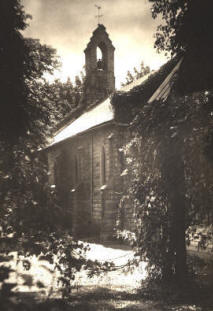
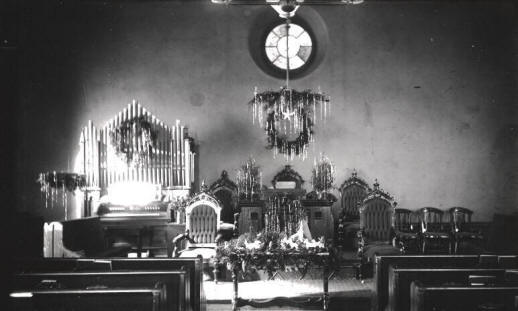
Early views by Kate Matthews. This was Annie Fellows Johnston’s Church, her pew a few rows back on the left side.
Fannie Craig (Miss Allison) played the organ. The organ and Annie’s pew (marked with a small plaque) still exist today
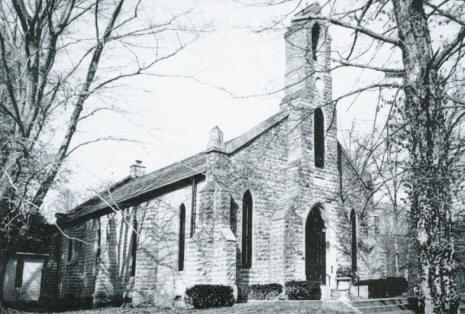
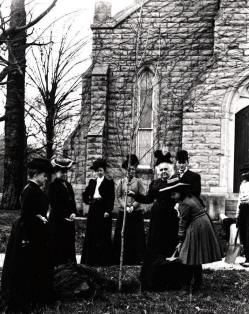
Famous Little Colonel characters help plant a tree, 1903
The Pewee Valley Presbyterian Church – or as Annie Fellows Johnston frequently describes it, “the little stone church with its ivy-covered belfry” — appears many times throughout the “Little Colonel” stories. Sometimes, she merely refers to it as a landmark, such as in this passage from Chapter V of “The Little Colonel at Boarding School”:
…From the post-office door, looking across the road to a grassy ridge beyond, one could see the big inn that the year before had been turned into a home for old Confederate soldiers. Farther on was the wide green slope of the churchyard, and the little stone church with its ivy-covered belfry. The manse stood just behind it. Next to that was the cottage with the high green gables and diamond-shaped window-panes, where the Waltons had lived one summer while their new house was being built. And next to the cottage was the new house itself, set away back in the great grove of trees which gave to the place the name of “The Beeches.”
Other times, she uses it as the setting for events in the stories, such as this scene from Chapter XV of “The Little Colonel at Boarding School”:
…In the hard work that followed after their return to school, time slipped by so fast that Thanksgiving Day came surprisingly soon. Nearly all the pupils and teachers went home for the short vacation, or visited friends in Louisville. Even the president and his wife went away. Only six girls besides Lloyd and Betty were left to follow the matron to church on Thanksgiving morning.
It was a lonesome walk. A Sabbath-like stillness pervaded the quiet Valley, and the ringing of the bell in the ivy-grown belfry of the little stone church, and the closed doors at the post-office, gave the girls the feeling that Sunday had somehow come in the middle of the week. As they crossed the road toward the iron gate leading into the churchyard, Lloyd looked up past the manse toward The Beeches, hoping for a glimpse of the Walton girls. Then she remembered that Allison had told her that they were all going to town to celebrate the day with her Aunt Elise, and the feeling of being left out of everybody’s good times began to weigh heavily upon her.
No smoke was coming out of any of the chimneys, either at The Beeches or Edgewood. When she thought of Locust, also cold and empty, with no fire on its hospitable hearths, no feast on its ample table, no cheer anywhere within its walls, and her family far away, a wave of homesickness swept ever her that brought a mist over her eyes. She could scarcely see as they went up the steps.
Mrs. Bond, with her usual dread of being late, had hurried them away from the seminary much too soon. Not more than half a dozen carriages had driven into the grove around the little country church when they reached the door, and only a few people were waiting inside. As Lloyd sat in the solemn silence that was broken only now and then by a stifled cough or the rustle of a turning leaf, she had hard work to battle back the tears. But with a sudden determination to overcome such a feeling, she sat up very straight in the end of the pew, and pressed her lips together hard.
“It’s almost wicked of me,” she thought, “to feel so bad about the one thing I can’t have when there are a thousand other things that ought to make me happy. It’s only a pah’t of my bo’ding school experiences, and will be ovah in a little while. I don’t suppose anybody in church has moah to be thankful for than I have.”
She glanced furtively across the aisle. “I’m thankful that I’m not that old Mistah Saxon with his wooden leg, or that poah little Mrs. Crisp in the cawnah, with five children to suppo’t, and one of them a baby that has fits.”
Her gaze wandered down the opposite aisle. “And I’m suah it’s something to be thankful for not to have a nose like Libbie Simms, or such a fussy old fathah as Sue Bell Wade has to put up with. And I’m glad I haven’t such pooh taste as to make a rainbow out of myself, wearing so many different colahs at once as Miss McGill does. Five different shades of red on the same hat are enough to set one’s teeth on edge. I believe I could go on all day, counting the things I’m glad I haven’t got; and as for the things I have —” She began checking them off on her fingertips. There was a handful before she had fairly begun to count; home, family, perfect health, the love of many friends, the opportunities that filled every day to the brim.
The organist pulled out the stops and began playing an old familiar chant as a voluntary. As the full, sweet chords filled the church Lloyd could almost hear the words rising with the music:
“My cup runneth over.
Surely goodness and mercy shall follow me
All the days of my life.”
As the music swelled louder, her counting was interrupted by the opening of the door and the entrance of several generations of the Moore family, who had come back to Oaklea for a Thanksgiving reunion. It seemed good to Lloyd to see the old judge’s white head gleaming like silver in its accustomed pew. His benign face fairly radiated cheerfulness and good-will as he took his place once more among his old neighbours.
Rob walked just behind him, so tall and erect, it seemed to Lloyd that he must have grown several inches in the three short months since they had cut the last notches in the measuring-tree. As he turned to throw his overcoat across the back of the seat, his quick glance spied Lloyd and Betty several pews in the rear, and he flashed them a smile of greeting. At the same time, so quickly and deftly that Mrs. Bond did not see the motion, he held up a package that be had carried in under his overcoat, and instantly dropped it out of sight again on the seat. Then he straightened himself up beside his grandfather, as if he were a model of decorum.
Lloyd and Betty exchanged a meaning glance which seemed to say, “That five-pound box of Huyler’s best he promised us;” and Lloyd found herself wondering several times during the long service how he would manage to present it. That problem did not worry Rob, however. As the congregation slowly moved down the aisles and out into the vestibule, he elbowed his way to Mrs. Bond, standing beside her eight charges like a motherly old hen.
“Good morning, Mrs. Bond,” he exclaimed, in his straightforward, boyish way. “You’re going to take me under your wing and let me walk to the gate with Betty and Lloyd, aren’t you! I’ll be as good as grandfather if you will, and I’ll even take him along if it’s necessary to have anybody to vouch for me.”
His mischievous smile was so irresistible that she gave him a motherly pat on the shoulder. “Run along,” she exclaimed laughingly. “I’ll follow presently. There are several people I want to speak to first.”
Of course, true “Little Colonel” fans know that the little stone church was where the Little Colonel married Rob Moore in Chapter XV of “The Little Colonel’s Knight Comes Riding”:
…It was just a quiet church wedding, as simple as it could possibly be made, in the late afternoon of one of the sweetest, goldenest October days that ever shone on the Valley. Only her most intimate friends were invited to the ceremony, because the little stone church is so small, but the doors were thrown open to everybody at the reception that followed at The Locusts.
Since the church has been frescoed inside and done over in soft cool greens, it makes me think of the heart of a deep beech woods. The light slips in through its narrow deep-set windows just as it does between the trees in the dim forest aisles. Lloyd wouldn’t have it filled with hothouse roses. She said nothing could be as appropriate as the wild flowers growing all around it in the country lanes and meadows. So there was nothing but tall plumes of goldenrod nodding in every open window, while the altar was a bank of snowy asters. She wanted them she said because aster means star, and it was at the altar her happiness would be written for her in the stars.
She said, too, that as long as it was in the country and she needn’t think of the conventions and could have things just as she pleased, she wanted it to be a white wedding — everybody in the bridal party to wear white. She said the old Colonel wouldn’t look natural to her in anything else that time of year and all the others would appear to better advantage. Every one said afterward what a beautiful picture it made. Rob and Malcolm and Keith and Ranald and Alex are all handsome young fellows anyhow, and they looked bigger and handsomer than ever in their immaculate white suits. Malcolm was best man and I was maid of honour. Kitty and Joyce and Katie Mallard were the bridesmaids. We girls carried armfuls of the starry asters and the men wore them as boutonnieres.
As for Lloyd, when she came out of her room, her dress trailing behind her like a soft, pure-white cloud, so light and airy it seemed as if it must have been woven on some fairy loom, and with a great cluster of lilies-of-the-valley in her hands, she looked to me just like one of her own lilies. Poor old Mom Beck, who had dressed her, stood behind her with the tears streaming down her black face, saying, “Honey, you sho’ly nevah will look moah like a blessed angel when you git through the pearly gates than you do this minute!”
From the look on Rob’s face as he met her at the white starry-crowned altar, I am sure he felt that he had already gone through “the pearly gates.” It was all so sweet and solemn, and as we listened to the words, “Whom God hath joined together,” I think we all felt that heaven’s own benediction rested on them, and would follow them all their way to the “Land o’ the Leal.”
Just as the Pewee Valley Presbyterian Church played an important role in the “Little Colonel” series, so did many of its members, who included Kate Matthews, or “Katherine Marks” in the stories; Judge Peter Brown Muir or “Judge Moore”; Annie Craig or “Grandmother McIntyre; and her daughter Fannie Craig or “Miss Allison.” Annie Fellows Johnston herself was also a member, according to “The United Presbyterian Church in Pewee Valley 1866-1966 100th Anniversary” booklet, portions of which are reprinted below:
History of the Pewee Valley Church
Pewee Valley is a suburban village eighteen miles from Louisville. The streets of the village, extending north and south along the LaGrange Road, are lined with tall trees forming Gothic Arches as they meet in the center. There is peach and serenity about the village which, in the latter part of the (20th) century, drew people away from the city to spend summers in the country. Other people had permanent residences nestled among the trees back from the street. There was a white wooden fence in front of each place, and stone gate posts marked the entrance.
To this charming spot in November of 1886 came a committee from the Presbytery of Louisville to consider organizing a church there. The committee consisted of the Rev. J. L. McKee, the Rev. James Lapley, and Elder J. B. Kinkade. A congregation was organized and officers were elected. On November 17, 1866, the Session met in the Methodist Church in Rollington, a small village north of Pewee Valley, and formally organized the Presbyterian Church of Pewee Valley. Among the organizing members were Alexander Craig, Annie Craig, Mr. and Mrs. J. H. Rohrer (who owned The Locust), Miss Sarah McKee, Mr. Charles B. Cotton (who was the son-in-law of poet W. D. Gallagher and owned the land where the Villa Ridge Inn and Confederate home later stood) , Miss Jennie Cotton, Mr. Thomas Barclay and Miss Jennie Mitchell.
While the church was being built, services were held in what in now the Parish House. It was built for a school where Mrs. Magruder, a sister of Judge Peter B. Muir, taught. Later it was used as a manse from the time of Dr. Cleland, 1884, until Dr. Hoge came in 1907….
Many laymen have contributed to the life of the Pewee Valley Presbyterian Church as Sunday School teachers, officers in the church or workers in the Women’s Organization, but few have contributed as much as Miss Mary T. Cleland. A history of the church would not be complete without mentioning the work and influence of “Miss Mamie.” She came to the church when her father came as pastor in 1884. From then until her death in 1856 she exerted an influence for good in the church and community. It was through her benevolence and generosity that the Manse on Maple Avenue came to the church. She gave encouragement and support to the young ministers who served the church. She kept a kindly eye on the young people of the church and was an influence for good in them. Her life has had a lasting effect on the life of her beloved church….
The records show that enrollment of the Sunday School varied from 115 to 145…The Sunday School Staff for many years consisted of Superintendent, Secretary, Librarian and Teachers. The Superintendents have been men who have been active in all phases of work in the church. Mr. H. M. Woodruff was superintendent in 1888, Mr. E. H. Matthews and Mr. F. E. Gatchel served as superintendents alternately from 1917 until Mr. Matthews’ death in 1933. Mr. Gatchel continued as superintendent until his death in 1947. Mr. Gatchel was also Sunday School teacher for the young people…
There have been many Sunday School teachers who have given years of dedicated and devoted service in teaching both children and adults; Miss Fannie Craig, Judge P. B. Muir, J. H. Rohrer, Mrs. J. M. Armstrong, T. H. Cleland and C. B. Cotton were some of the teachers in the years 1868 through 1894. In the early years of the nineteen hundreds: Cary Hoge, Mrs. Annie Fellows Johnston, Miss Kate Matthews, and E. H. Matthews were teachers, with Mrs. Cleland still teaching the Primary Class.
Until about 1929 all the Sunday School classes were held in the various corners of the sanctuary. Mrs. Cleland’s Primary Class met to the right of the organ and Mrs. Grundy’s (Mrs. Grundy was Louise Cleland’s stepdaughter) class met to the left of the organ. In 1927 when Mrs. Cleland became ill, she had been teaching the Primary Class in the Pewee Valley Church for forty-two years….
It is interesting to note that there has always been a Church Library. Miss Fannie Craig served as librarian in her lifetime….
The Women of the Church
The Women of the Church have manifested their faith through the stewardship of their time and money. An earlier history of the church written by Miss Kate Matthews and Mrs. Bessie Wood contains some items which bear out this statement:
“The young people workers in the Pewee Valley Church in 1888 were known as the Busy Bees, comprising about fifteen in number. The older people were known as the Missionary Society, about 12 in number.”
“In 1894 the Busy Bees merged into the King’s Daughters; then the King’s Daughters became the Ladies Aid Society in 1909, doing local benevolences, etc.”
“Money was raised by the sale of the Little Colonel post cards, suppers, food sales, bazaars, movies, rummage sales, ice cream fetes, valentine parties, Easter festivals, Dr. Cotton’s annual suppers for his students, white elephant sales, cafeteria suppers, colonial teas, silver teas, traveling baskets, and sums made individually by the turn-over of a fifty cent piece and later on a quarter.”
“All the prominent members of the Presbyterian Church were always willing to work. The names of all the presidents are as follows (through 1939): Mrs. J. M. Armstrong, Mrs. Blanch Smith, Mrs. Reynard, Mrs. H. W. Woodruff, Mrs. T. H. Cleland, Miss Fanny Craig, Mrs. Thomas Floyd Smith, Mrs. Morris Gifford, Mrs. W. K. Allen, Mrs. Jacob Herdt, Mrs. C. M. Osborn, Miss Lillian Fletcher, Miss Mary T. Cleland, Mrs. William Herdt, Mrs. O. M. Tomlinson (first auxiliary president).”
Miss Kate Matthews was treasurer for sixty years. When she retired, a gift in her honor was given to the Seminary for the student loan fund to help individual students when times of financial crisis arose.
Music of the Church
There are many who must be remembered for their ministry to the church through music. One of the first organists was Russell Armstrong. In the late eighteen hundreds and early nineteen hundreds, Miss Fannie Craig was the organist. In 1908 an Aeolian organ was given to the church by Mr. and Mrs. S .A. Culbertson in memory of Alice Craig Gatchel (her photo with Annie and Fannie Craig) and more about her tragic death at age 28. Miss Fannie Craig played it until the new electric organ was bought in 1925. A tribute to her is found on the plaque on the organ with the inscription, “Her whole life was a service of love.”
Biographies of the Pastors and Stated Supplies of the Church during the Little Colonel and Annie Fellows Johnston years:
1885-1892 Dr. Thomas Horace Cleland
Dr. Thomas Horace Cleland was born Dec. 19, 1816 in Mercer County, Kentucky. When he was sixteen, he joined the Presbyterian Church of New Providence, Kentucky. He was graduated from Centre College in 1838. After spending two years in Lane Theological Seminary, he entered Princeton in 1840 for his third year. He was ordained at Grier’s Creek, Kentucky, on November 12, 1841. He taught in the high school in Lebanon, Kentucky and was stated supply at Bethel and Lebanon, Kentucky. During the years 1884 and 1885 he did work as an evangelist in Kansas and Kentucky. he was pastor of the Pewee Valley Presbyterian Church from 1885 until his death in 1892. He received an honorary degree of D.D. from Hanover College, Indiana.
1892-1899 The Rev. James Curry Randolph
The Rev. J.C. Randolph was born in Mercer County, Kentucky in 1830. He was graduated from Centre College in 1852 as valedictorian of his class. He taught at Stanford and Nicholasville, Kentucky. He was the first student to matriculate in the Danville Theological Seminary, where he was graduated in 1856. After the war (Civil), he was elected to chair of mathematics in Centre, which he held for nearly twenty years. At the same time, he was pastor of the church at Lancaster, Kentucky. He served the Presbyterian Church in Shelbyville, Kentucky, for a short time before he was called to the Pewee Valley Church in 1892. He preached there until failing health compelled him to give up his work in 1899. He died in 1902.
Rev. Creighton1900-1907 The Rev. Cyrus Murry Creighton
 The Rev. Cyrus Murry Creighton was born in 1873, was graduated from Park College in 1897 and the Presbyterian Theological Seminary in Chicago in 1900. Park College gave him an honorary D.D. degree, and after his ordination in 1900, he held pastorates in Pewee Valley, Kentucky (1900-1907) Ypsilanti, Michigan (1907-1911) and Newark, New York (1913-1926). He died in 1926.
The Rev. Cyrus Murry Creighton was born in 1873, was graduated from Park College in 1897 and the Presbyterian Theological Seminary in Chicago in 1900. Park College gave him an honorary D.D. degree, and after his ordination in 1900, he held pastorates in Pewee Valley, Kentucky (1900-1907) Ypsilanti, Michigan (1907-1911) and Newark, New York (1913-1926). He died in 1926.
1907-1929 Dr. Peyton Harrison Hoge, D.D.
 Dr. HogeDr. Peyton H. Hoge, Pastor and Pastor Emeritus of Pewee Valley Church from 1907-1929, was born on January 6, 1854 at Hampden Sidney, Virginia. He worked his way through Hamden Sidney College and the Theological Seminary at Richmond Virginia. He was ordained and installed as pastor of Grace Mission, which is now the Grace Covenant Presbyterian Church of Richmond, Virginia. In 1884 he was called to succeed Dr. Joseph R. Wilson, father of Woodrow Wilson, as pastor of the First Presbyterian Church at Wilmington, North Carolina. In 1899 he was called to the Warren Memorial Presbyterian Church, (formerly at Fourth and Broadway, Louisville Kentucky.) (webmaster’s note: The Culbertson’s/Two Little Knights of Kentucky family were members of The Warren Memorial, and one would suppose many of the Little Colonel folks attended there if they were in Louisville on a Sunday Morning)
Dr. HogeDr. Peyton H. Hoge, Pastor and Pastor Emeritus of Pewee Valley Church from 1907-1929, was born on January 6, 1854 at Hampden Sidney, Virginia. He worked his way through Hamden Sidney College and the Theological Seminary at Richmond Virginia. He was ordained and installed as pastor of Grace Mission, which is now the Grace Covenant Presbyterian Church of Richmond, Virginia. In 1884 he was called to succeed Dr. Joseph R. Wilson, father of Woodrow Wilson, as pastor of the First Presbyterian Church at Wilmington, North Carolina. In 1899 he was called to the Warren Memorial Presbyterian Church, (formerly at Fourth and Broadway, Louisville Kentucky.) (webmaster’s note: The Culbertson’s/Two Little Knights of Kentucky family were members of The Warren Memorial, and one would suppose many of the Little Colonel folks attended there if they were in Louisville on a Sunday Morning)
As a member of the Board of Trustees of the Louisville Presbyterian Seminary, he was chairman of the building and fund raising committee and was responsible for planning and building of the Quadrangle at First and Broadway. A Homiletics class room in the Caldwell Chapel of the new Seminary is dedicated to his memory.
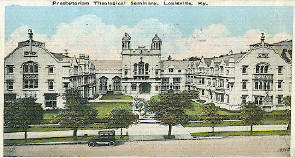
In his retirement sermon, Dr. Hoge claimed one virtue, “I have preached Christ.” His scholarly sermons were characterized by the depth of his understanding of what it meant to preach Christ. During his ministry to the Pewee Valley Church, he made significant contributions to the music program by both directing the choir, his own singing, and setting certain parts of the Psalms to music.
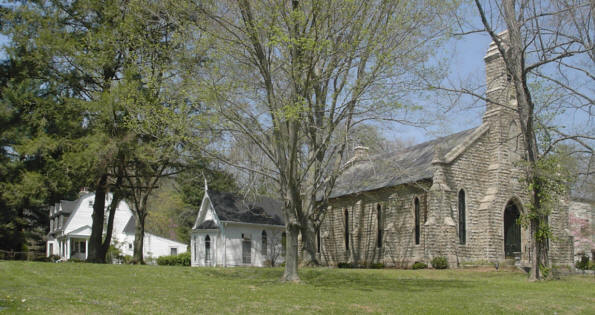
Pewee Valley Presbyterian Church, 2005
Recent view of the church. The manse still stands to the rear, and further back is “The Gables.”
Today, the little stone church that so captured Annie Fellows Johnston’s imagination is well on its way to reaching its sesquicentennial. Sunday school and worship services continue each week and fish fries are still held on the occasional Friday night. At midnight on Christmas Eve, the usually silent ivy-covered belfry awakens and the bell peals “glad tidings of great joy” which can be heard throughout the Valley. Twice every Sunday, the ivy-covered belfry calls the congregation to worship, and at midnight on Christmas Eve, the bell peals “glad tidings of great joy” which can be heard throughout the Valley.
For more information on the church today, visit their website at http://www.peweevalleypresbyterian.org/about.asp.
Page by Donna Russell